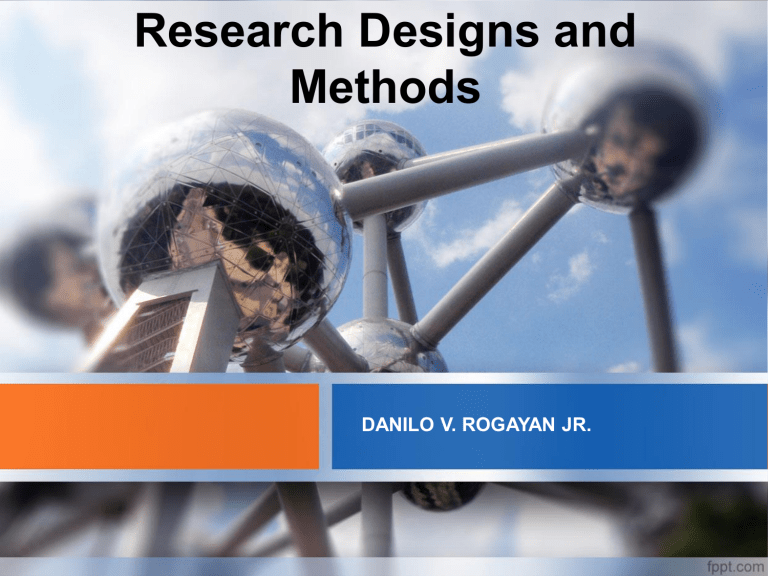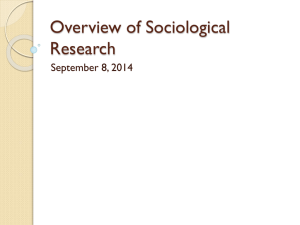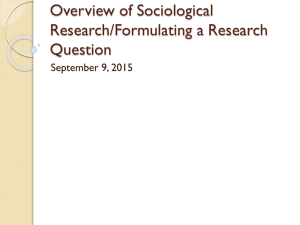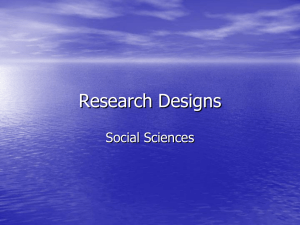
Research Designs and Methods DANILO V. ROGAYAN JR. Research Design • Research design refers to the plan and structure of the investigation used to obtain evidence to answer research questions. • It describes the procedures for conducting the study, including when, from whom, and under what conditions the data will be obtained. • It indicates how the research is setup: what happens to the subjects and what methods of data collection are used (Mcmillan and Schumacher,1993). Purpose of research design • To provide the most valid, accurate answers possible to research questions. Major types of designs • Research designs are classified into two major types—the quantitative and the qualitative designs. Quantitative designs gather and analyze numerical data while qualitative data make use of narrative or verbal data. Types of Research Designs Quantitative Experimental Nonexperimental True Descriptive experimental Correlation QuasiSurvey experimental Ex post facto Single subject Qualitative Ethnographic Analytical Concept analysis Historical analysis Legal analysis Quantitative Designs • These research designs were initially developed from research in agriculture and the hard sciences. It emphasized objectivity and quantification of phenomena. The designs maximize objectivity by using numbers, statistics, structure and experimental control. Quantitative designs are grouped into experimental and non-experimental studies. Quantitative Designs • 1. Experimental design is when the researcher manipulates what the subject will experience. The investigator has some control over what will happen to the subjects by systematically imposing or withholding specified conditions. Experimental studies are more frequently conclusive because they involve the principles of control, randomization, and comparison. Experimental Design • Variable is a qualitative or a quantitative entity that can vary or take on different values. These are measured and represent the concepts studied. They are often classified as dependent (cause) or dependent (effect) variables. • Control is the cornerstone of experimental design. It involves holding a variable constant or varying it systematically so their effects can be removed from study or compared to other conditions. • Comparison between subjects who had the treatment and those who did not will help determine the effect of the treatment being studied. Types of Experimental Designs • 1. True experimental design has the unique characteristic of randomly assigning subjects to different groups. With a good number of samples, this procedure ensures that there are no major differences between subjects in two groups before the treatment begins. Types of Experimental Designs • 2. Quasi-experimental design approximates the true experimental type. Its purpose is to determine cause and effect. There is direct manipulation of conditions but there is no random assignment of subjects. Quasi-Experimental Design • Common situation: Several classes or schools that can be used to determine the effect of curricular materials or teaching methods. Although the classes are already intact and have different teachers, an experimental treatment may be given to some of the classes and the other classes can be the controls. Types of Experimental Designs 3. Single-subjects designs offer an alternative by specifying methods that can be used with single individual. Similar to the quasi-experimental, there is manipulation but no random assignment. This is O-X-O design where observation (O) is conducted before the intervention (X) or treatment has been introduced and the observation continues after the intervention to determine if the treatment really brought the changes in the behavior of the subjects. Non-Experimental Design • Studies using the non-experimental design describe something that has occurred or examine relationships between things without suggesting direct cause-and-effect relationships. Non-Experimental Design • 1. Descriptive design describes existing phenomena by using numbers to characterize individuals or a group. It assess the nature of existing conditions. There is no manipulation of treatments or subjects; the researcher measure things as they are. Descriptive Design • Purpose: characterizing something as it is. • Questions that can be answered using the descriptive design: • What is the reading achievement level of different ethnic groups in the school? • What are the student’s attitudes towards school discipline? • How many times in month does Mrs. Juan use negative reinforcement with her pupils? Non-Experimental Design 2. Correlational research design is technically a form of descriptive designs, but because it is used extensively in education, it is classified as a distinct type of research. This design is concerned with assessing relationships between two or more phenomena. It involves a statistical measure of the degree of relationship, called correlation. This measure is a statement about the degree of association between the variables of interest. Non-Experimental Design 3. Survey research is where the investigator selects a sample of subjects and administers a questionnaire or conducts interviews to collect data. It is frequently used to describe attitudes, beliefs, opinions, and other types of information. It is also used to infer on a population using the response obtained from a smaller group of samples. Survey Research • Uses: • Describe the frequency of demographic characteristics or traits held, • Explore relationships between different factors, • Delineate the reasons for particular practices. Non-Experimental Design 4. Ex Post Facto design is used to explore possible relationships among variables that can be manipulated by researcher. The investigator compares two or more samples that are comparable except for specified factor. The possible cause are studied after they have occurred. The research focuses on what happened differently for comparable groups of subjects, then explores if the subjects in each group are different in some way. Ex Post Facto • Sample problem: • Do kids who went to more academic day care programs have higher levels of school readiness than those who went to less academic day programs? QUALITATIVE RESEARCH DESIGNS • Qualitative designs are less structured than quantitative ones. It investigates behavior as it occurs naturally in noncontrived situations, and there is no manipulation of conditions or experience, hence, the term ‘naturalistic inquiry’. QUALITATIVE RESEARCH DESIGNS • The specific procedures of a qualitative design are identified during the research rather than before it is conducted which is why it is called emergent design. Each step depends on prior information collected during the study. QUALITATIVE RESEARCH DESIGNS • A case study design distinguishes a traditional qualitative research, wherein a single case is studied in depth. It can be an individual, one group of students, a school, a program, or a concept. The purpose is to understand the person (s) or phenomena. Data consist of words in the form of rich verbal descriptions, rather than numbers. QUALITATIVE RESEARCH DESIGNS • The naturalistic inquiry was defined as a discovery-oriented approach that minimizes investigator manipulation of the study setting and places no prior constraints on what the outcomes of the research will be (Guba, in Patton, 1993). Types of Qualitative Designs • Ethnographic Designs • Ethnography is the work of describing a culture. Its central aim is to understand another way of life from the native point of view. It means learning from people. Ethnographic studies rely on observation, interviewing and document analysis. Typically, the researcher is at a selected site for a long period of time to understand fully the subjects and phenomena being studied. Types of Qualitative Designs • Analytical Designs • Analytical designs investigate problems through an analysis of documents. The researcher identifies studies and then, synthesizes the data to provide an understanding of events that may or may not have been directly observable. The purpose of the study is to understand the past event, person, or movement by a thorough and detailed description and analysis. The researcher interprets these facts to provide explanations of the past and clarifies the collective educational meanings that may be underlying current practices and issues. Analytical Design Subtypes • Concept analysis is the study of education concepts such as “open education”, “ability grouping”, or “leadership” to describe the meaning and appropriate use of the concept. • Historical analysis involves a systematic collection and criticism of documents that describe past events. The analysis examines causes and trends and often relates the past to current events. • Legal analysis focuses on selected law and court decisions to better understand the “law” and legal issues. Data Collection • Quantitative Techniques • Quantitative techniques emphasize a priori categories to collect data in the form of numbers. Its goal is to collect data to provide statistical descriptions, relationships and explanations. It is used with experimental, descriptive and correlational designs as way to summarize a large number of observations and to indicate numerically the amount of error in collecting and reporting the date. Methods of Data Collection Quantitative Types: Structured observations Standardized interviews Test Questionnaires Unobtrusive measures Characteristics: +Instruments are used in data collection +Data appear as numbers +A priori* decision in data collection and presentation +Data takes one form – response as determined by instrument. +Data are tabulated and describe statistically +Meaning is derived from statistical procedure employed Qualitative Ethnographic observation Ethnographic interview Documents +Data collected without an instrument +Data appear as words +Not a priori decision on data presentation; depends on data collected +Data may take many forms – field note, documents, interview notes, or tapes +Tabulations limited to help identify patterns; used to support qualitative meanings +Meaning is derived from qualitative strategies Quantitative Tecniques • Structured observation is a where researcher directly observes visually and auditory, some phenomenon and then systematically records the resulting observations. The points to be observed are predetermined before the conduct of the study and will be recorded in an identified system of recording. Quantitative Tecniques • Standardized Interview is an oral, inperson administration of a standard set of questions that is prepared in advanced. Questions are usually structured or semistructured. Responses are coded, tabulated and summarized numerically. Quantitative Tecniques • Questionnaires encompass a variety of instruments in which the subject responds to written questions to elicit reactions beliefs, and attitudes. Quantitative Tecniques • Tests refer to the use of scores as data. It involves subjects response to either written or oral questions to measure knowledge, ability aptitude, or some other trait. Quantitative Tecniques • Unobtrusive measures are applied when the subjects are unaware of being participants in the study. This eliminates the sources of bias that are present when respondents realize that they are a part of the study. Qualitative Techniques • Ethnographic Observation has the distinctive feature of observing phenomena in naturally occurring situations over an extended time and writing extensive field notes to describe what happened. Qualitative Techniques • Ethnographic interview is characterized as an unstructured or in-depth interview. There maybe a general interview guide but not a set of specific questions worded precisely the same for every interviewee. The interviewer usually encourages the person to talk in detail about areas of interest. Often the interview is taped and transcribed to analyzed common themes or results. Qualitative Techniques • Documents are record of past events that are written or printed; they be letters, court record, official minutes, diaries, tax records, regulations, laws, etc. Historical, legal and some policy-making studies are examples of research that depend on documents as the source of data. Much of the researcher’s time is spent on locating documents with specialized bibliographies and indexes and in analyzing the sources. References • • • • • • • • • • • • • • • • Ardales, V.B. 1992. Basic Concepts and Methods In Research. Quezon City: Great Books Trading Ariola,M..M.. 2006. Principles and Methods of Research.1st edtion. Manila: Rex Book Store Bautista, O.K. 2006. Technical Writing. A Lecture given during the Training Workshop on Technical Writing At PCARRD, Los Banos., Laguna Belmont Report. 1979. Ethical Principles and Guidelines for the Protection of Human Subjects of Research. Washington Best, J.W. and J.V. Kahn.1989. Research In Education. 6th Edition.New Jersey, USA: Prentice Hall. Calderon, J.F. and E.C. Gonzales. 1993. Methods of Research and Thesis Writing. Manila: Great Books Trading Calmorin, L.P. and M.A. Calmorin 2005. Methods of Research And Thesis Writing. Ist Edition. (Reprint) Manila: Rex Books Store. De Leon, S.Y. and V. Claudio. 1980. Guide to Research and Scientific Reporting. Manila: Merriam. Espiritu, J.A. 2014. Research Methodology. Unpublished Manual. Fraenkel, J. and N. Wallen. 2007. How to Design and Evaluate Research in Education, 6th Edition. New York, USA: McGraw Hill Companies, Inc. Gregorio, G.L. 2000. Research Methods and Technical Writing in Agriculture. Manila: Rex Printing Company. Librero, F. How to Write A Thesis Proposal. Department of Development Communication, College of Agriculture. Laguna, Philippines: UPLB. Mcmillan J. and Schumacher. 1993. Research in Education – A Conceptual Introduction. New York, USA: HarperCollins College Publishers. Sanchez, C.A. 1986. Methods and Techniques of Research. Manila: Rex Bookstore. Sevilla, C. et al. 1988. An Introduction to Research Methods. Manila: National Book Store Maraming salamat! That in all things God may be glorified!





